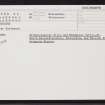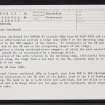Newbigging
Linear Earthwork (Period Unknown)
Site Name Newbigging
Classification Linear Earthwork (Period Unknown)
Alternative Name(s) Raedykes Intrenchment
Canmore ID 36973
Site Number NO88NW 23
NGR NO 8440 8961
NGR Description NO 8440 8961 to 8423 8955
Datum OSGB36 - NGR
Permalink http://canmore.org.uk/site/36973
- Council Aberdeenshire
- Parish Fetteresso
- Former Region Grampian
- Former District Kincardine And Deeside
- Former County Kincardineshire
NO88NW 23 8440 8961 to 8423 8955.
The linear earthwork (to NO89SW 2) extends 190m from NO 8423 8955 and is situated in dense afforestation astride a ridge some 230m S of the marching camp and parallel to the SSE rampart of the latter. It terminates at the NE end on marshy ground and at the SW end on the steepening slopes of the ridge. It comprises a strong earth-and-stone rampart, of which the more westerly is either caused by, or accentuated by a drainage ditch. The position of the work relative to the marching camp, effectively blocking any approach along the ridge from a low hill to the SE, confirms that it is an outwork to the camp.
Visit by OS June 1966.
An unusual linear earthwork 180m in length, runs from ENE to WSW through a small forestry plantation on the SE side of the public road to the E of New bigging steading. The bank is up to 4.5m thick and 1.2m high, and the ditch is up to 4m broad and 1.1m deep; there are two gaps in the earthwork, which stops abruptly at both ends. There is no evidence for the date or purpose of this earthwork but it may be associated with Raedykes Roman Temporary Camp (NO89SW 2).
RCAHMS 1984, visited November 1983
Field Visit (2 May 1957)
‘Intrenchment’, Raedykes.
The plantation in which this earthwork is situated had been felled and only recently replanted at the date of visit so that the work was clearly visible. It consists of a bank and ditch on the south side, and its course is accurately mapped on the 6-inch OS map. Starting at the east end, on the edge of the road, the work has been denuded for a distance of 22 yards. The follows a fine stretch 60 yards in length whose profile is given below [see WP 000776, 20] and in the Note Book (S10, 11) [MS 36/177]. Although the OS map shows the ditch as a water-course, not much scouring seems to have taken place—the total volume of the ditch being very little more than that of the bank.
At the end of the 60 yards, there is a gap of 20 feet which looks original, although it is impossible to be sure of this without excavation. Then follows a 40 yards stretch where the earthwork is slightly less substantial than before, the total width of the bank and ditch being reduced to 30 feet and the bank standing to a maximum height of 8 feet above the bottom of the ditch. There does, however, seem to have been some scouring here in the ditch. Traces of revetting of large stones can be seen on the outer scarp of the bank about half way along this sector. They occur about 3ft 6in from the top of the bank, i.e. at about the ground level on either side of the earthwork, and give a width of about 17ft for the bank at this point. Another gap follows, 12 yds wide and probably secondary, after which the bank resumes with a width of 15 ft and a height of only 2ft 6in. The ditch profile has been wrecked by later drainage but it is not as wide nor as deep as further east. The west end of the work has clearly been destroyed by former cultivation, but the east end may be original since there is no signs of any continuation in the plantation on the opposite side of the road. Further east the line is continued by a gulley which was no doubt marshy in former times and which would itself form as a boundary line.
There is not sufficient evidence to say definitely whether the work is Roman or not, although after investigating Raedykes marching-camp [NO89SW 2] I am inclined to think that it is. The dimensions of the best-preserved sector are similar to the Raedykes rampart and ditch at their maximum size, and the Raedykes rampart also shows an external stone revetting in places (apart from the piece which is almost wholly formed of boulders). It also faces away from the marcing-camp, and to that extent serves as a covering defence; but it is curious that it looks south on to ground which is overlooked from within the camp.
Visited by RCAHMS (K Steer) 2 May 1957.












